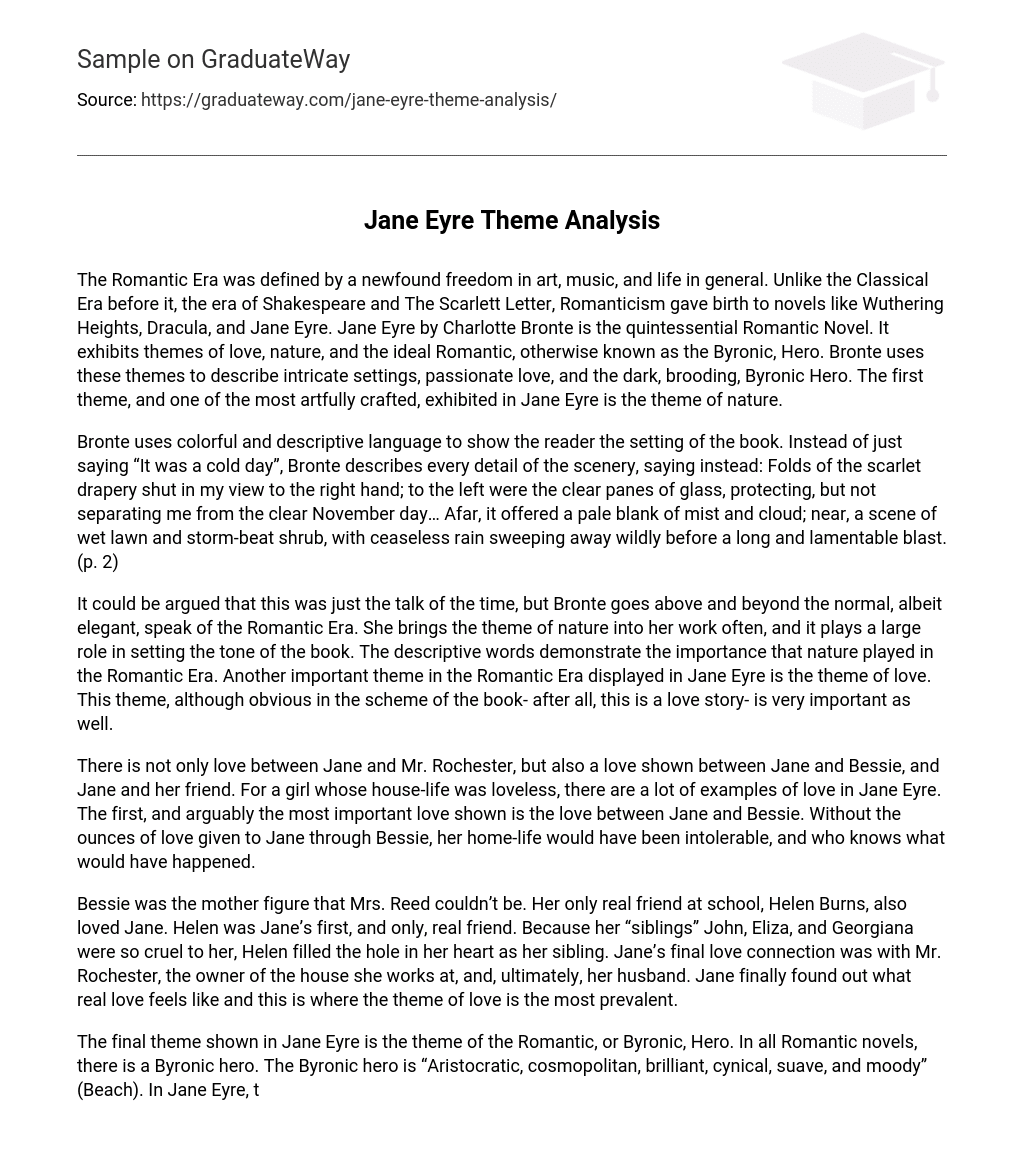The Romantic Era saw a newfound freedom in art, music, and life in general, setting it apart from the previous Classical Era. This era, which included the works of Shakespeare and The Scarlett Letter, gave rise to novels like Wuthering Heights, Dracula, and Jane Eyre. Jane Eyre, written by Charlotte Bronte, stands as the quintessential Romantic Novel that explores themes of love, nature, and the ideal Romantic Hero, commonly known as the Byronic Hero. Bronte employs these themes to depict intricate settings, passionate love, and the dark and brooding characteristics of the Byronic Hero. An exquisitely crafted theme in Jane Eyre is the theme of nature.
Bronte skillfully utilizes vivid and expressive language to effectively portray the setting in the book. Rather than simply stating that it was a cold day, Bronte meticulously depicts every aspect of the scenery: The folds of scarlet drapery obstructed my view to the right, while on the left, clear glass panes shielded me from, but did not isolate me from, the clear November day… In the distance, it presented a pale expanse of mist and clouds; nearby, a scene of drenched grass and battered shrubbery, with unrelenting rain being hastily carried away by a long and mournful gust of wind (p. 2).
Bronte surpasses the typical discourse of the Romantic Era by incorporating the theme of nature into her work, which significantly influences the book’s tone. The descriptive language utilized underscores the significance of nature during this literary period. Additionally, Jane Eyre exemplifies another prominent theme of the Romantic Era: love. While it may be evident as a love story, the theme of love remains crucial within the narrative.
The love in Jane Eyre is not limited to the relationship between Jane and Mr. Rochester. It is also evident in Jane’s connections with Bessie and her friend. Despite growing up in a loveless household, there are several instances of love in Jane’s life. One significant example is the love between Jane and Bessie. Without the love that Bessie gives to Jane, her home-life would have been unbearable, and the outcome could have been uncertain.
Bessie served as the mother figure that Mrs. Reed failed to be, while also being Jane’s only true friend at school. Helen Burns, who was also dear to Jane, became her first and only genuine friend. In the midst of her siblings’ cruelty towards her, Helen became a sibling-like figure and filled the void in Jane’s heart. Ultimately, Mr. Rochester, the owner of the house where Jane works and later marries, became her final love connection. It is in this relationship that Jane truly experiences the essence of genuine love, making it the predominant theme.
The theme of the Romantic, or Byronic, Hero is the final one depicted in Jane Eyre. In every Romantic novel, a Byronic hero can be found. The characteristics of a Byronic hero include being aristocratic, cosmopolitan, brilliant, cynical, suave, and moody (Beach). Mr. Rochester in Jane Eyre embodies all these qualities, along with being sarcastic, selfish, and rude. He mistreats his employees to some extent and is initially unkind to Jane upon her arrival at his estate.
Mr. Rochester, exhibiting the conduct of an ideal Byronic Hero, isolates himself for consecutive days within the confines of his room, abstaining from social interaction. The underlying themes prevalent in Jane Eyre undeniably portray it as the quintessential Romantic Novel, embodying the key ideas and motifs of that era’s literature. Nature, love, and the notion of the Byronic Hero, inspired by Lord Byron, permeate the entirety of the novel, thus establishing it as an exemplary representation of the Romantic Era.





